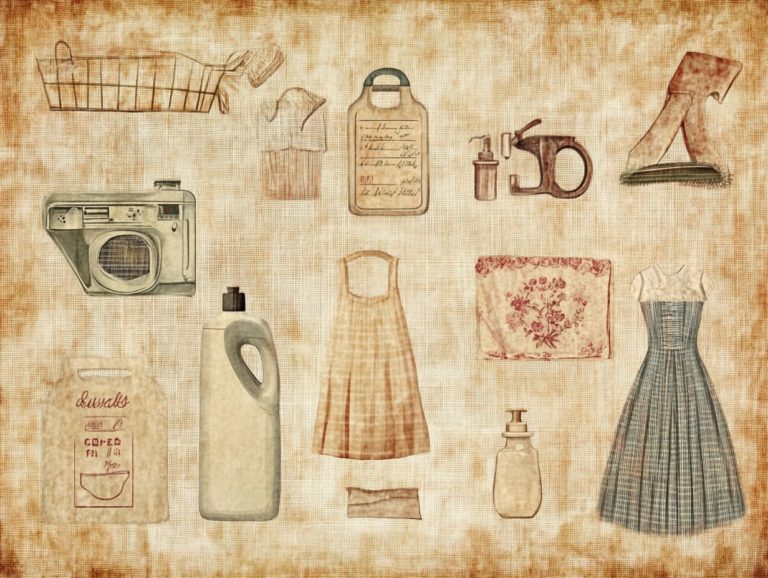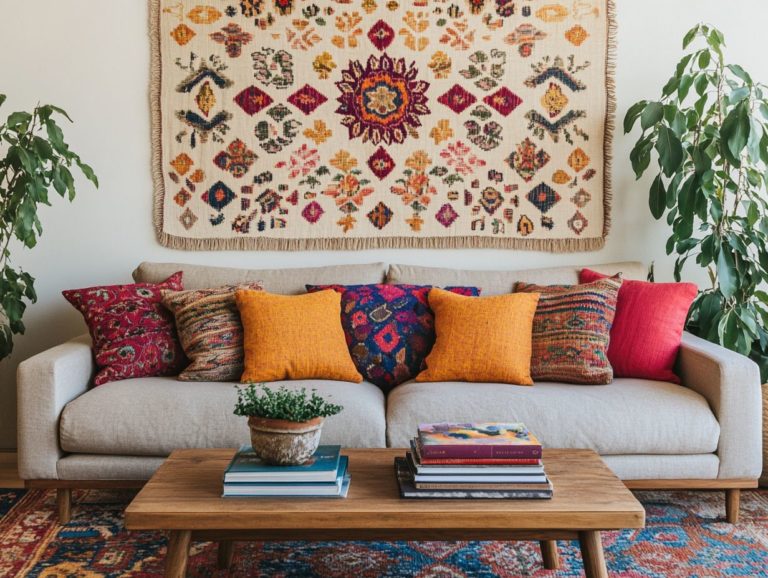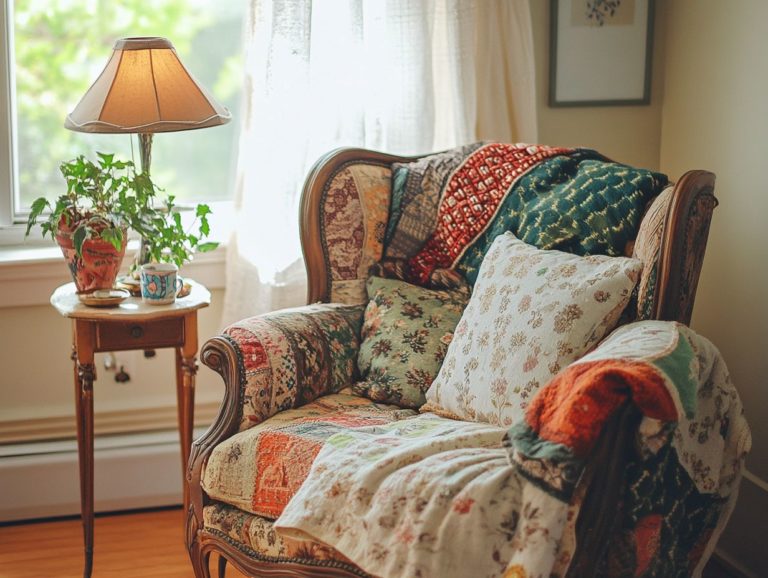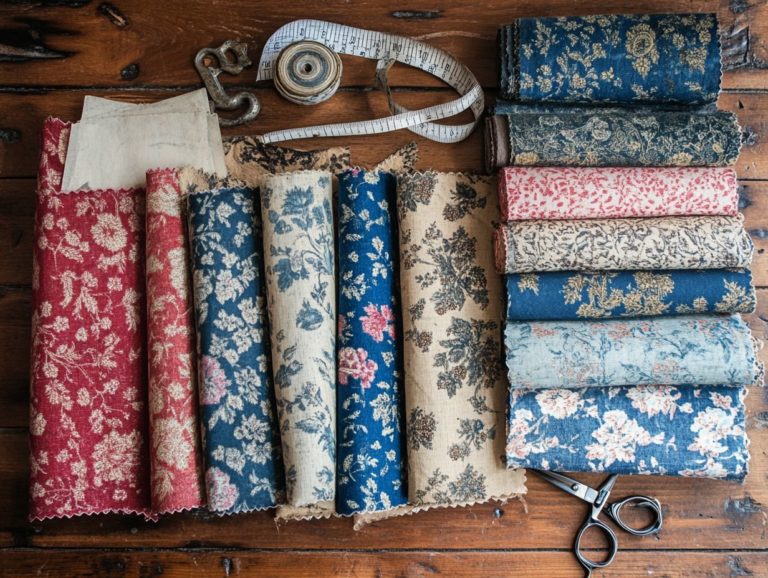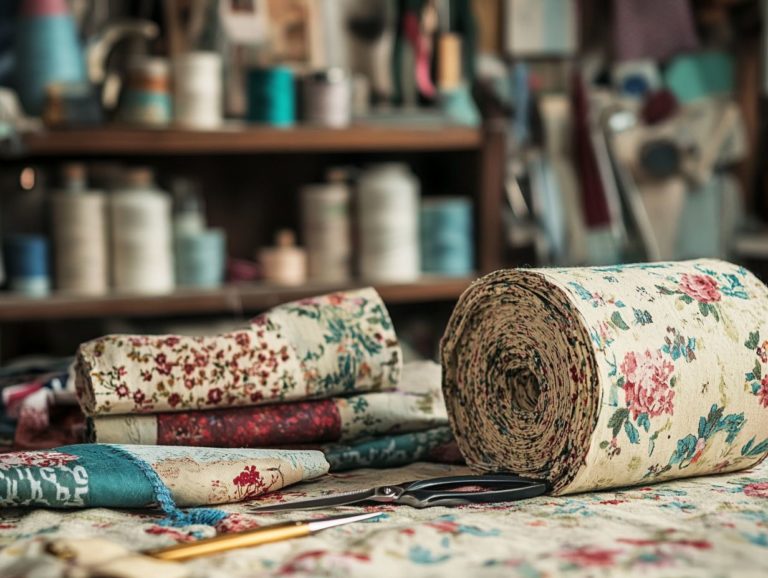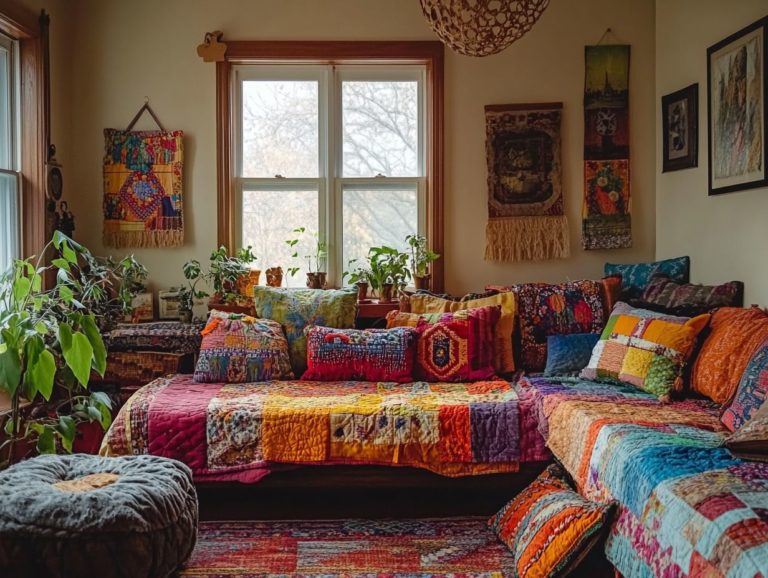The Impact of Vintage Textiles on Eco-Friendly Design
In recent years, you may have noticed the surge in sustainable fashion, with eco-friendly design becoming an essential part of the industry. At the heart of this movement is the use of vintage textiles a practice that honors the past while championing environmental responsibility.
This exploration delves into the rise of eco-friendly design, highlighting the significant role vintage textiles play and the advantages and challenges they bring.
Join us as we explore this exciting blend of tradition and sustainability, uncovering valuable insights for designers and the trends shaping the future of fashion.
Contents
- Key Takeaways:
- The Rise of Eco-Friendly Design
- The Role of Vintage Textiles in Eco-Friendly Design
- Advantages of Using Vintage Textiles
- Challenges and Limitations of Vintage Textiles
- Incorporating Vintage Textiles into Eco-Friendly Design
- The Future of Vintage Textiles in Sustainable Fashion
- Frequently Asked Questions
- What are vintage textiles and how do they impact eco-friendly design?
- How does using vintage textiles contribute to sustainable fashion?
- What are some popular vintage textiles used in eco-friendly design?
- Can vintage textiles be used in high fashion designs?
- Aside from sustainability, are there other benefits to using vintage textiles in design?
- How can consumers support the use of vintage textiles in eco-friendly design?
Key Takeaways:

- Eco-friendly design is on the rise, with a growing understanding of the importance of sustainable fashion.
- Vintage textiles play a crucial role in eco-friendly design, with a long history and evolution in the fashion industry.
- Using vintage textiles offers environmental benefits and addresses ethical considerations. However, challenges such as availability and quality must also be considered.
The Rise of Eco-Friendly Design
The emergence of eco-friendly design signifies a transformative shift within the fashion industry, where sustainable living and environmental consciousness are taking center stage. This movement invites you to embrace craftsmanship that values not just aesthetics but also the planet s well-being.
It challenges conventional manufacturing processes, advocating for innovative practices such as recycling fabrics, utilizing deadstock materials, and celebrating vintage textiles infused with cultural heritage and distinctive patterns.
As you become more aware of textile waste, you are drawn towards thoughtful shopping, making informed choices that actively support a circular economy.
Understanding the Importance of Sustainable Fashion
Understanding the importance of sustainable fashion is essential in today s world. It directly addresses the significant environmental impact of textile waste produced by the fast fashion industry.
This concept emphasizes the need to reduce waste while nurturing a culture of responsible consumption among shoppers like you.
By investing in high-quality garments designed for longevity, you play a vital role in alleviating the harmful effects associated with disposable clothing, including pollution and resource depletion.
Sustainable fashion encourages you to think critically about your purchases, urging you to seek out brands that prioritize ethical production practices and aim for lower carbon footprints.
Ultimately, embracing this mindset fosters a more equitable society and promotes environmental stewardship for future generations. Your choices can lead to meaningful change.
The Role of Vintage Textiles in Eco-Friendly Design
Vintage textiles are crucial for you, as these distinctive pieces not only showcase exquisite craftsmanship but also offer a sustainable alternative to current fashion choices.
By embracing vintage textiles, you promote the recycling of fabrics and play a part in preserving cultural heritage.
History and Evolution of Vintage Textiles
The history and evolution of vintage textiles unveil a rich tapestry of craftsmanship, cultural heritage, and artistic expression that mirrors societal shifts over time.
Iconic figures like William Morris and Lucienne Day have stood at the forefront, championing unique patterns and innovative designs that continue to captivate.
As you explore various movements such as the Arts and Crafts Movement of the late 19th century and the Mid-Century Modern era you will discover how these designers have made enduring contributions that resonate with contemporary creators.
Vintage textiles are not merely remnants of the past; they embody the spirit of their times and often serve as a canvas for political and social commentary.
In today s world, where sustainability takes center stage, these fabrics have reclaimed their significance. They remind us of the importance of repurposing and honoring history within eco-friendly design initiatives, inspiring a revival of traditional techniques while seamlessly integrating modern innovations.
Act now to rediscover the power of vintage textiles in shaping a sustainable future!
Advantages of Using Vintage Textiles
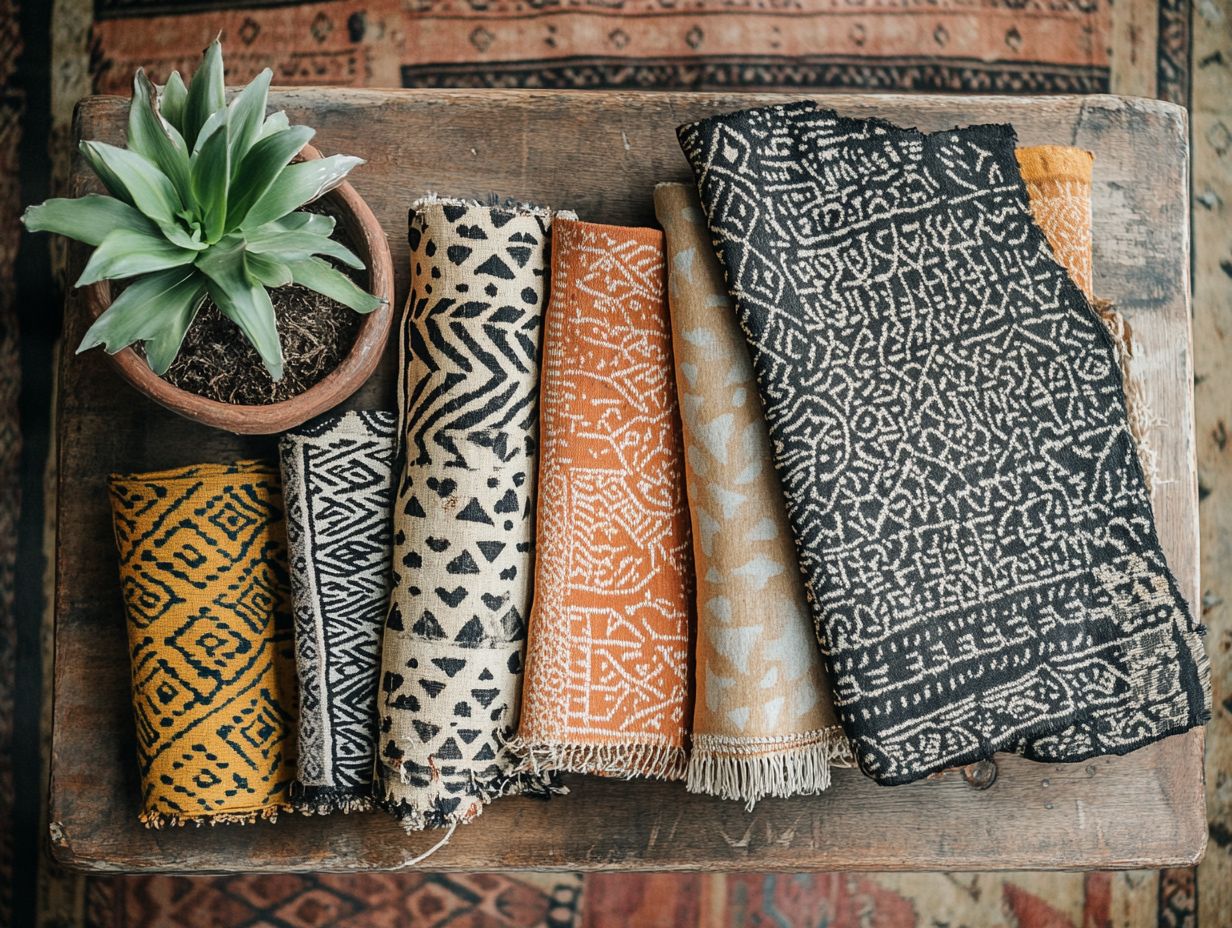
The advantages of incorporating vintage textiles into your life are exciting and varied! Not only do they provide significant environmental benefits by reducing fabric waste, but they also embody ethical considerations that support mindful shopping and celebrate the artistry of unique craftsmanship.
Environmental Benefits
The environmental benefits of using vintage textiles are noteworthy. They significantly reduce textile waste and support a circular economy by recycling fabrics.
By extending the life cycle of existing materials, vintage textiles help lessen the volume of fabric that ends up in landfills. These landfills can take decades if not centuries to decompose. In fact, the U.S. alone discards over 11 million tons of textile waste each year. This shocking fact shows we urgently need sustainable alternatives.
When you choose vintage fabrics, you conserve valuable resources like water and energy, which are typically consumed in the production of new textiles. Consider this: producing just one cotton t-shirt requires around 2,700 liters of water. In contrast, repurposing vintage items not only saves water but also energy, fostering a more sustainable approach to fashion.
Case studies from circular fashion initiatives reveal that embracing vintage textiles can significantly reduce carbon footprints. This paves the way for a more sustainable future.
Ethical Considerations
Ethical considerations surrounding vintage textiles focus on promoting conscious consumerism and honoring the remarkable craftsmanship behind authentic, high-quality garments.
This choice encourages a meaningful departure from the fast fashion mindset. It highlights the significance of sustainable practices that minimize environmental impact. By selecting vintage pieces, you actively support eco-friendly principles and explore the role of vintage fabrics in sustainable decor, ultimately playing a role in reducing waste.
Engaging with vintage textiles fosters a deeper connection to the artisans and communities that create them. It helps preserve traditional techniques that might otherwise fade away. By appreciating these unique garments, you contribute to fair labor practices and bolster local economies. This reinforces the vital importance of ethical consumption in today’s marketplace.
Challenges and Limitations of Vintage Textiles
While vintage textiles present a wealth of benefits, you must also navigate several challenges and limitations. Key among these are the hurdles of availability and sourcing, alongside the need to guarantee quality and durability in these distinctive pieces.
Availability and Sourcing
The availability and sourcing of vintage textiles pose a complex challenge in the fashion industry. Here, the demand for unique pieces often surpasses the supply of deadstock fabric and genuine vintage finds. This disparity limits the variety of materials at your disposal as a designer. It also complicates your efforts to curate collections that resonate with consumers seeking individuality.
Market saturation can further blur the lines of authenticity regarding vintage offerings. This may leave you and other buyers confused about the integrity of certain textiles. To navigate these intricacies, more designers like you are turning to specialized sourcing networks and vintage fairs. They are forging connections with trusted suppliers who prioritize the quality and history of their materials.
Collaborative efforts between designers and textile archivists can breathe new life into hidden gems from the past. This ensures that the fashion landscape remains vibrant and sustainable for all.
Start your vintage journey today and make a difference!
Quality and Durability

Vintage textiles can vary in quality and durability. This often reflects the craftsmanship and materials used by past designers.
For instance, textiles crafted from natural fibers like silk, cotton, and wool typically demonstrate greater resilience compared to synthetic counterparts. The techniques used ranging from detailed weaving designs to careful dyeing processes play a crucial role in determining their longevity.
As you seek out vintage pieces, pay close attention to details such as texture, coloration, and signs of wear. These elements provide insight into the textile’s overall health. Understanding the historical context and common practices of specific eras enriches your selection process, ensuring each piece tells a compelling story and becomes a lasting treasure in your collection. Additionally, consider the role of vintage accessories in sustainable design as you curate your collection.
Incorporating Vintage Textiles into Eco-Friendly Design
Incorporating vintage textiles into eco-friendly design is a fantastic way to foster sustainable living while creating unique fashion pieces. This approach often involves upcycling textiles, which means reusing old fabrics to create new items that tell a story.
Tips and Techniques for Designers
Designers aiming to include vintage textiles in their eco-friendly creations can use a wealth of tips and techniques that promote both creativity and sustainability.
By selecting materials that narrate a story and minimize waste, you can elevate your projects to extraordinary heights. Explore local flea markets, estate sales, or online vintage retailers to uncover unique fabrics that add character to any collection.
Integrating these textiles into modern designs through deliberate layering or repurposing enhances their aesthetic appeal. This creates a captivating visual narrative. Promoting sustainable choices on social media and through eco-conscious partnerships fosters community engagement and solidifies your commitment to preserving the planet’s resources.
The Future of Vintage Textiles in Sustainable Fashion
The future of vintage textiles in sustainable fashion is poised for remarkable growth. Emerging trends and innovative practices increasingly emphasize their significance in eco-friendly design and conscious consumerism.
This evolution boosts the beauty of fashion and promotes sustainability.
Trends and Innovations
Trends and innovations in the realm of vintage textiles are transforming sustainable fashion, providing exciting opportunities to embrace craftsmanship and creativity in your collections.
As you navigate the growing demand for eco-friendly options, reviving these unique materials helps reduce waste and weaves a narrative rich in historical significance. Many designers are exploring upcycling techniques, breathing new life into discarded fabrics and celebrating artisanal skills that prioritize quality over quantity. Incorporating vintage furniture can also play a significant role in creating eco-friendly homes.
This movement highlights the increasing importance of transparency in sourcing, guiding designers to make informed choices. Ultimately, integrating vintage textiles fosters a profound appreciation for craftsmanship and champions a shift towards a more circular fashion economy, reshaping your approach to modern garment creation.
Frequently Asked Questions

What are vintage textiles and how do they impact eco-friendly design?
Vintage textiles refer to fabrics and materials produced decades ago that have been recycled or repurposed for contemporary use. These materials positively impact eco-friendly design by reducing the consumption of new resources and minimizing waste in the fashion industry.
Explore vintage textiles today and make a sustainable choice for your wardrobe!
How does using vintage textiles contribute to sustainable fashion?
Using vintage textiles helps fashion brands lower their carbon footprint. It also supports a system that reduces waste by reusing materials.
What are some popular vintage textiles used in eco-friendly design?
Popular vintage textiles include repurposed denim, silk scarves, and vintage lace. These materials add unique elements to designs while having a smaller environmental impact.
Can vintage textiles be used in high fashion designs?
Definitely! Vintage textiles add luxury and exclusivity to high fashion. Many designers show that sustainability and style can go hand in hand.
Aside from sustainability, are there other benefits to using vintage textiles in design?
Yes, vintage textiles often come with rich histories. They add a unique nostalgia to designs and support small businesses that repurpose these materials.
How can consumers support the use of vintage textiles in eco-friendly design?
Consumers can support this movement by buying from sustainable brands that use vintage materials. They can also explore vintage shops or repurpose old materials through DIY projects.

